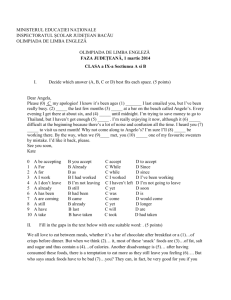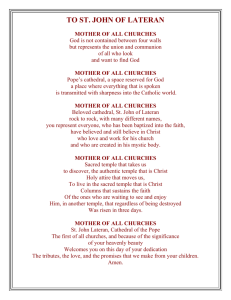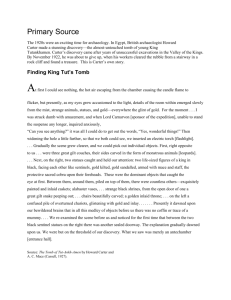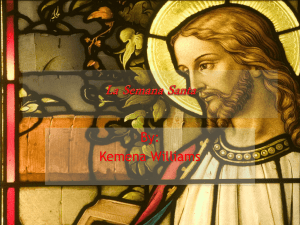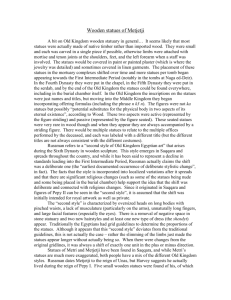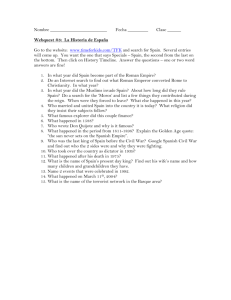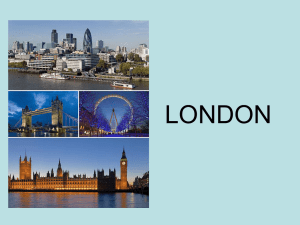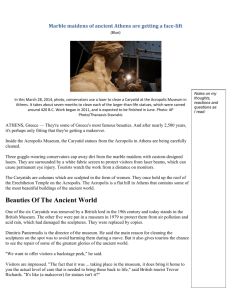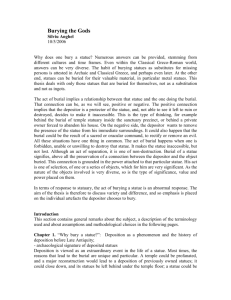Seville, Spain" by Theresa Albert
advertisement
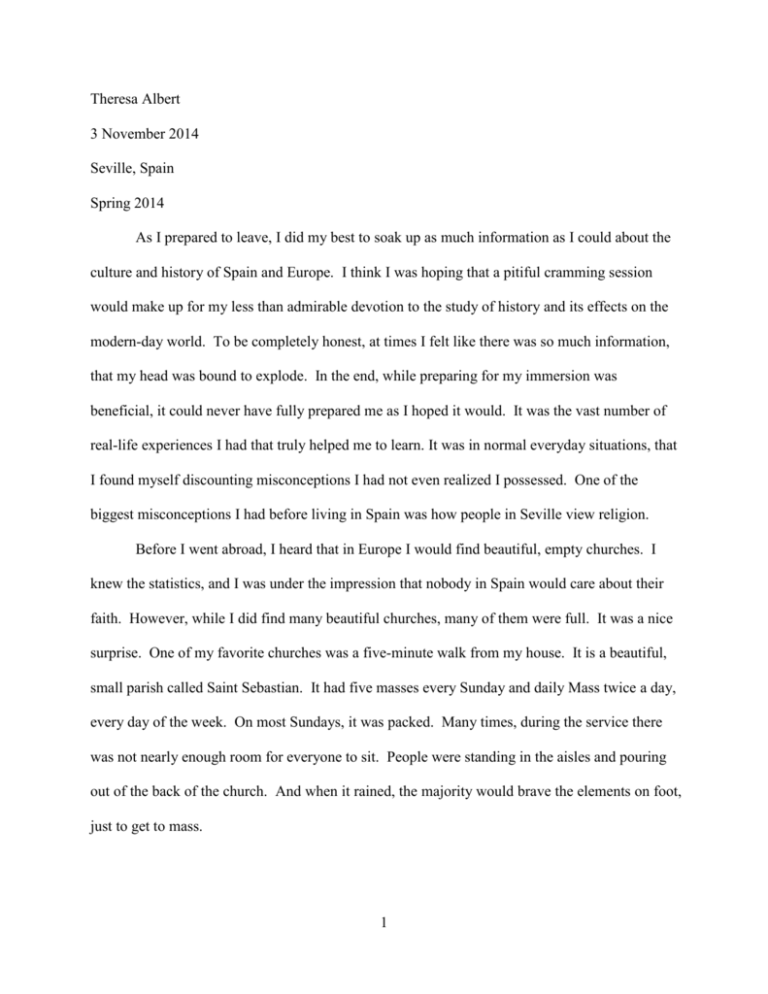
Theresa Albert 3 November 2014 Seville, Spain Spring 2014 As I prepared to leave, I did my best to soak up as much information as I could about the culture and history of Spain and Europe. I think I was hoping that a pitiful cramming session would make up for my less than admirable devotion to the study of history and its effects on the modern-day world. To be completely honest, at times I felt like there was so much information, that my head was bound to explode. In the end, while preparing for my immersion was beneficial, it could never have fully prepared me as I hoped it would. It was the vast number of real-life experiences I had that truly helped me to learn. It was in normal everyday situations, that I found myself discounting misconceptions I had not even realized I possessed. One of the biggest misconceptions I had before living in Spain was how people in Seville view religion. Before I went abroad, I heard that in Europe I would find beautiful, empty churches. I knew the statistics, and I was under the impression that nobody in Spain would care about their faith. However, while I did find many beautiful churches, many of them were full. It was a nice surprise. One of my favorite churches was a five-minute walk from my house. It is a beautiful, small parish called Saint Sebastian. It had five masses every Sunday and daily Mass twice a day, every day of the week. On most Sundays, it was packed. Many times, during the service there was not nearly enough room for everyone to sit. People were standing in the aisles and pouring out of the back of the church. And when it rained, the majority would brave the elements on foot, just to get to mass. 1 Part of the beauty of being Catholic is having the ability to be able to go to almost anywhere in the world, and know you will be able to find a place where mass will be celebrated. Of course, every parish and every country worships a little differently. Language, music and seating arrangements are bound to be different from one place to another. But despite this, the most important parts of mass are the same everywhere. But sometimes it is those little things that can either make us feel included or left out. I spent most of my time in Seville trying to acclimate myself to the Spaniard way of worship. Unfortunately, for a lot of the time, I felt quite overwhelmed. There was often a mix of knowing exactly what was happening (the Readings, the Gospel, the Offertory etc.) and at the same time not having a clue as to what was going on. However, whenever it came time for the Consecration, I always knew exactly what was happening. I didn't need a translator, a dictionary or a culture guide. In those instants, thousands of miles from Michigan, I was home. Another important part of religion in Seville is called Semana Santa, or Holy Week. For hundreds of years, each parish has had between 1 and 3 statues depicting moments from Christ's passion and death that they carried to the Cathedral on their assigned day. The processions can last between four and twelve hours depending on how far away the church is from the Cathedral. Throughout the week, there are more than fifty processions. Many of the parishioners walk with the processions, and for each procession, there are hundreds of participants. They are called nazarenos and wear long robes and carry long candles. The robes cover everything but their eyes, and they are complete with a pointy hood. Most of the time, people from the United States are a little put off by the nazarenos because their attire is somewhat similar to members of the Ku Klux Klan. However, these two groups are completely 2 unrelated. The nazarenos were around hundreds of years before the KKK and their reasons for dressing the way they do are completely distinct. Well, I guess their reasons are the same. They both want to conceal their identity, but the nazarenos are not committing crimes. They conceal their faces because the walk to the Cathedral should be offered as a sacrifice to God. They hide themselves so that God is the only one who sees them. Some nazarenos also go barefoot and/or carry crosses. This is symbolic of following Christ's example and taking up our own crosses in life. But unlike the Ku Klux Klan, they are not violent in any way. While I was learning about these traditions, I really was not sure what I would think. One thing people told me before Semana Santa was that there would be people all along the street drinking and laughing. The idea of this bugged me a lot. I pictured a penitential journey surrounded by debauchery and irreverence, but that's not what it was. Yes, there were people drinking, eating and laughing. The processions are a really social time. However, what I realized was that this atmosphere was similar to what you would have experienced if you had walked the Way of the Cross with Jesus on that first Good Friday. The reality is that people were not at a church service that day. Crucifixions were entertainment. So while the processions of Semana Santa are not necessarily the greatest place for quiet contemplation, it is an awesome experience if you want to understand a little more what it would have been like to be in a crowd on the way to Calvary. Furthermore, when the statues go by, there is a reverent hush that falls over the crowd. Most people stop their conversations and focus on the image that passes them. This leads me to my next point. The thing I was most afraid of during Semana Santa was that the behavior toward the statues would be idolatrous. I thought this because I heard that people had certain statues of Mary that they liked better than others, or that people try to touch 3 the statues as they go by because it is considered good luck. That all just sounded a bit weird to me, and not at all in line with Church teaching. But as I was standing in the crowd while the statues passed by in front of me it did not seem as though the behavior was idolatrous. It is entirely possible that someone there was worshiping the statues, but that was in no way, shape or form the purpose of the processions. The purpose of the processions is to help Christians visualize what happened to Christ. To see a life-like replica of Christ carrying his cross can send chills running down one’s spine. There is really no way to describe it. It just makes you understand more deeply the reality of what happened. Looking at the expression of his mother, it is like we are there and we can feel her sorrow. Because whether you believe Mary was sinless or not, whether you think she was ever-virgin or had thirteen kids, you cannot deny that she felt pain when she saw Jesus suffer. The Bible tells us she was there until the end, a model of devotion. She was human, and that was her son. He was hurting, and there was nothing she could do to stop it. Of course she was in pain, but she stayed with him despite this. In the end, I came to the conclusion that it is not the statues themselves that are important. It is the devotion to God they inspire. They help people to understand the life of Christ, in the same way that the words in the Bible do. Living in Spain forced me to reevaluate how I understand religion. It was a valuable experience that helped me to recognize both the similarities and the differences between Catholic churches in the United States and in Spain. 4

